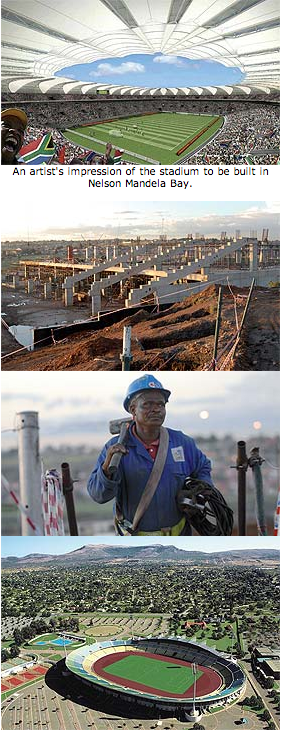 The building and up-grading of stadiums for the 2010 World Cup has started.
The building and up-grading of stadiums for the 2010 World Cup has started.
Even though stadiums are not built in every village or town in the country, all South Africa will benefit from 2010.
Stadiums and roads are not only being upgraded where the official World Cup games will be played. Some municipalities are upgrading smaller stadiums in their towns. These stadiums will be used for warm-up matches and training.
So, whether you live a few metres from Soccer City where the opening and closing ceremonies will take place, or many kilometres away, the benefits of the world's biggest soccer tournament should find you.
Some people will be able to get jobs during the building and upgrading of stadiums, roads and services like electricity and telephone lines.
Long after the 2010 World Cup, there will be benefits because the stadiums are built as multi-purposes centres. This means they will not only be used for soccer, but also for sports like rugby, tennis and athletics and for other gatherings.
Some permanent jobs will also be created because the stadiums have to be maintained and managed. Local people and small businesses will benefit from this.
"We can't afford a situation like in South Korea and Japan where they had to tear down stadiums after the World Cup because there was no further use for them," said Local Organising Committee head, Danny Jordaan.
"When the soccer has come and gone, something of value must remain that is there for all to see and enjoy."
The Stadiums
-
Royal Bafokeng stadium in North West, Nelson Mandela Bay stadium in the Eastern Cape and the Free State stadium will all accommodate 42 000 people after the upgrade in December 2008.
-
Peter Mokaba stadium in Limpopo and Mbombela stadium in Mpumalanga will seat 46 000 when they are completed in October 2009.
-
Soccer City in Johannesburg is expected to be finished in October 2009. It will have 95 000 seats.
-
Ellis Park in Johannesburg should be completed by December 2009. It will carry 61 000 people.
-
In Pretoria, Loftus stadium will seat 50 000 people when completed in December 2008.
-
King Senzangakhona stadium in Durban and the Green Point stadium in Cape Town will both seat 70 000 people when completed in October 2009.
- Ndivhuwo Khangale



 Facebook
Facebook Twitter
Twitter WhatsApp
WhatsApp